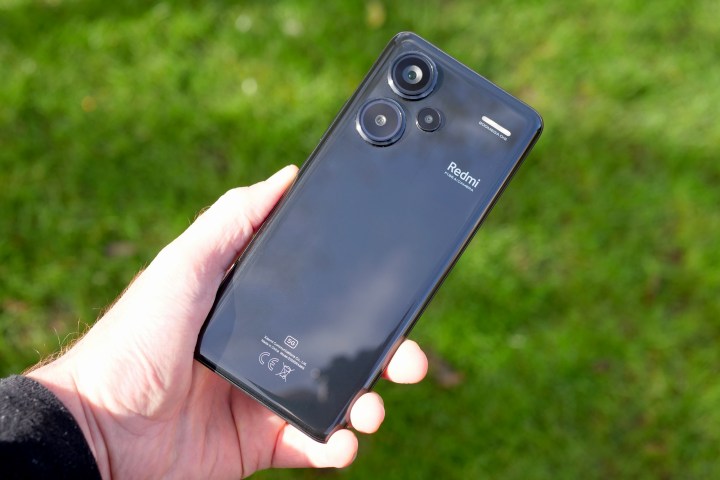
Before I put my SIM card in the Redmi Note 13 Pro Plus, I had seen several reports and YouTube videos claiming it would be a great purchase if you didn’t want to buy an expensive smartphone like the Samsung Galaxy S24 or even the Apple iPhone 15 Pro Max. Wow, I thought: It must be really special. While it’s not especially cheap, the latest Redmi phone does look like a good value, at least on paper.
Well, it is quite good, but there’s absolutely no reason to buy it if you can stretch to a more expensive phone. Although it hasn’t been any trouble, I’m itching to switch to a different phone, and it’s one that costs exactly the same amount of money to buy. The reason why isn’t to do with the specs as such but to do with life with the phone.
It’s not all about the numbers

Numbers are the basis of many arguments about why midrange phones like the Redmi Note 13 Pro Plus are a shrewd buy instead of a lavish model like a Galaxy S24 Plus or iPhone 15. The Redmi Note 13 Pro Plus has a big 6.67-inch screen, a 200-megapixel main camera, a 5,000mAh battery, and a 120W fast charger. Impressive, big numbers that can even shame more expensive phones when compared to each other on paper.
It’s very easy to get distracted by this during efforts to reduce the most important number involved in purchasing a new phone — the price. The Redmi Note 13 Pro Plus costs 450 British pounds, or around $570, which is half that of the Google Pixel 8 Pro and the iPhone 15 Pro. Neither of those has 120W charging, so we’re clearly being ripped off, and brands like Xiaomi (which owns the Redmi brand) are doing us all a favor by exposing it.
But what the numbers don’t tell you is what the phone is like to use every day. I’m not about to bash the Redmi Note 13 Pro Plus; it’s actually quite good, but I do want to point out that by spending more, the quality of life with your chosen device is increased, and friction is decreased. Yes, friction, as the Redmi Note 13 Pro Plus can really make things hard some days, and who wants to add that to their life?
A great screen, with missing features

The Redmi Note 13 Pro Plus has a 6.67-inch AMOLED screen with a 2712 x 1220 pixel resolution and a 120Hz refresh rate and is covered in Gorilla Glass Victus. It’s bright and detailed enough, although it is a little cold compared to the cozy warmth of the iPhone 15 Pro’s screen. Outside in the sun, it gets very bright when you activate Sunlight mode (although you have to do this manually, and I’ve no idea why it’s not automatic). Although it stretches to a 120Hz refresh rate, it doesn’t reduce it down far enough to conserve battery life.
However, for the most part, none of this really bothers me. Far more egregious is the lack of an always-on ambient display. I consider this to be an essential feature on any phone, regardless of price, provided the technology enables it. I can’t see any reason why the Redmi Note 13 Pro Plus omits it and only allows it to show on-demand. It’s annoying on Motorola phones and annoying here, too.
I just want to see the notifications I may have missed when I look at the phone’s screen without having to tap it or press the power button. Why? When I try on the Redmi Note 13 Pro, the face recognition tries to kick in, and if it doesn’t see me, it forces me to unlock the phone manually just to see the notifications. It happens regularly, and the phone gets very confused, resulting in a slowdown. This is friction, and it could all be avoided if the ambient display was on all the time.
The camera is excellent but with a catch

I’ve been really impressed with the Redmi Note 13 Pro Plus’s 200MP main camera and the photos it takes. It’s almost the phone’s savior, as I love the colors, the balanced contrast and exposure, and the amount of detail in good lighting. It even performs well at night. If I only ever wanted to take photos with the main camera, the Redmi Note 13 Pro Plus would satisfy me.
Except I don’t, and the other cameras on the phone are a little disappointing. Adding a 2MP macro camera is practically unforgivable these days. Although I like the tone and colors of photos taken with the 8MP wide-angle camera, it does lack detail when you look closely. While I don’t shoot much video, it maxes out at 30 frames-per-second (fps) at 4K resolution, and the quality isn’t very good either. The camera looks great on paper, but it doesn’t quite live up to the promise when you examine it more closely.
The main camera is the only one I’d ever regularly use on the Redmi Note 13 Pro Plus, and that seems like a waste, as the specification is definitely selling something greater. That said, although the spec appears the same as the Redmi Note 12 Pro Plus, the 13 Pro Plus’s camera is a considerable improvement. It’s my favorite part of the Redmi Note 13 Pro Plus, but I also know other phones are equally good or even better.
Very fast charging

Very fast charging is technically exciting — the Redmi Note 13 Pro Plus’s battery took just 23 minutes to get to 100% in my test — and can be extremely helpful, but not everyone will find it so. I charge my phone overnight, so ultimately, it doesn’t matter if it takes 23 minutes or five hours to charge it fully. I find better power efficiency more appealing, and I’ve recently discovered that the latest, highest-spec processors excel at it.
Better efficiency can cancel out the need for fast charging entirely, as it modulates power consumption based on your use and potentially extends battery life out into multiple days. This doesn’t happen with the Redmi 13 Pro Plus — I’ve made the battery last for two full days on a single charge, though — in the same way as it does with the OnePlus 12 or Galaxy S24 Ultra. Don’t get caught up in the numbers related to charging; think about how you use your phone before getting sold on a feature you may not always use.
Outdated and frustrating software

No matter how much money I spend on a new smartphone, I want to see the latest version of the operating system installed on it. The Redmi Note 13 Pro has the MIUI 14 interface, which may make you believe it’s Android 14 underneath, but it’s not. Instead, this new phone runs Android 13. There’s just no excuse for it, regardless of whether there’s that much difference between Android 13 and 14. It’s a 2024 smartphone, and it should have the latest version of Android installed.
Xiaomi’s software update schedule is shorter than on many more expensive phones, but it’s slightly more understandable given the price and likelihood of someone keeping it for many years. But there’s no reason why the Redmi Note 13 Pro Plus doesn’t have Android 14. Well, no good reason for a consumer, but Xiaomi will be looking at how many updates it has promised to offer and also when it plans to send out its new HyperOS software as reasons to hold back.
But much worse than this is the overall experience. I don’t want to think about the software too much, and I’m forced to do so on the Redmi Note 13 Pro Plus. There’s a lot of friction. When you set a PIN or adjust other important settings, the button to move to the next step has a timer to ensure you’ve read it every single time. Apps appear over multiple home screens even though I tell them not to do so, Android buttons and not gestures are still the default control system, the notification shade is split into two and awkward to use with one hand, there are so many pre-installed apps, and ads with a timer appear when I go to change the wallpaper. I’m looking for a far simpler life than this.
What else is there?

The Redmi Note 13 Pro is a good smartphone, but it’s not always much fun to live with. The one smartphone I’m itching to switch to from the Redmi Note 13 Pro, because it solves almost all my frustrations with the Redmi phone, is the Google Pixel 7a. It’s the same price, has better, newer Android 14 software, an always-on display, an equally capable camera, and I don’t really mind about the charging speed.
If my budget could stretch a little further, the Nothing Phone 2 has bags of personality, a strong processor, a decent camera, and fun software based on Android 14. Or, the next step up would be the Google Pixel 8, which has all the Pixel 7a’s goodness, with the much improved Tensor G3 processor. I love phones that offer great value for money, and all these do a good job, including the Redmi Note 13 Pro Plus. But I’m less keen on those that introduce unwanted friction into my life. Sadly, the Redmi phone does add a little too much of it, and it’s something the specs will never be able to tell you.
Editors' Recommendations
- 5 phones you should buy instead of the Samsung Galaxy S24
- A new Motorola phone just leaked, and it could beat the Galaxy S24 Ultra
- A phone you haven’t heard of just beat the Galaxy S24 Ultra in a camera test
- 5 phones you should buy instead of the Samsung Galaxy S24 Ultra
- Why I ditched my iPhone 15 Pro for the Samsung Galaxy S24 Ultra










